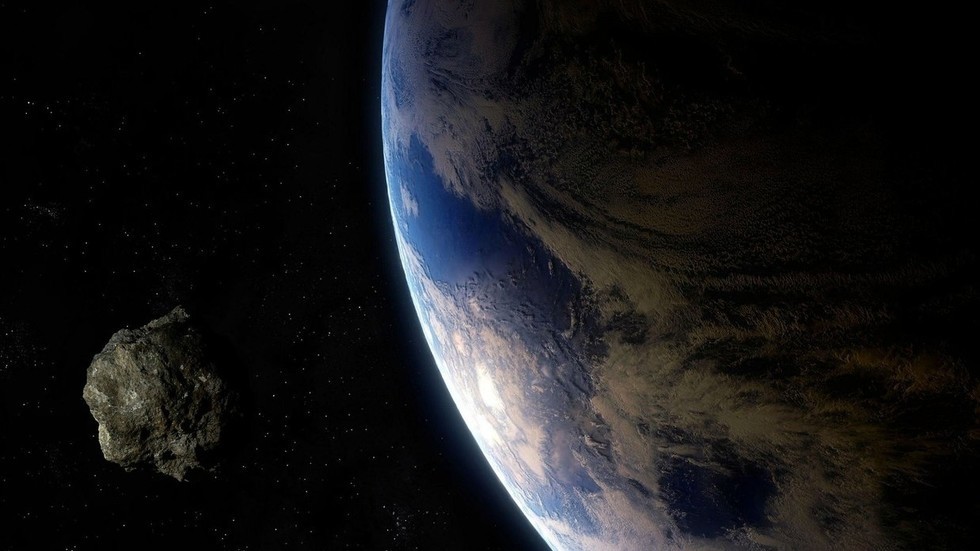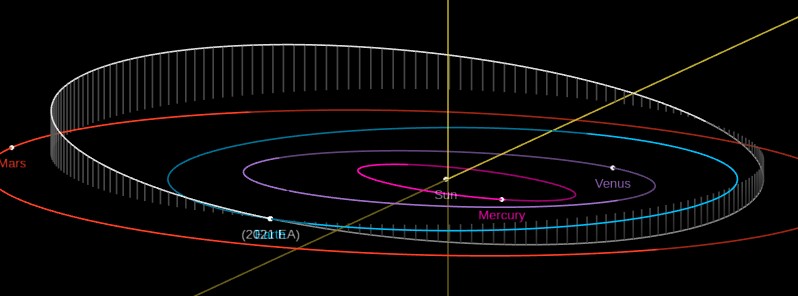As I was writing on the previous posts regarding the possibility of extrapolating from observations of fireballs in the US and Japan to the situation in the whole world, I began to reconsider a model for the amount of NEO flybys and the chances of a hit. I believe the model I once worked on needs to be reworked and new figures calculated. This post is divided into sections, and results are especially in the second but last.
Correcting an error and improving a model for calculating the number of flybys
In this post from 2019 I wrote:

If one in the above model expanded the radius r of the Earth, the area hit by the rays of the Sun would increase. The area would increase at a rate of the radius squared, as the formula for the area A of a sphere is 4*pi*r^2. If we inflated the Earth to twice the size it would make the radius equal to 2r, then the whole surface area would take up
4*pi*(2r)^2=4*(4*pi*r^2).
In the picture, the spot closest to the equator gets the same amount of energy as the spot further away, but no matter the spot, if one doubles the radius the surface taken up by the spots would become four times larger and they would receive four times more energy. One difference between this model looking at the rays of the Sun and one looking at possible impacts is that while the rays of the Sun come from one direction, the impacts could come from many directions. Still, the area increases in proportion to the radius squared.
Redoing the model for the number of flybys between us and the Moon
If we expanded the globe out to the average distance of the Moon, then the radius would have expanded a lot more. In the old post there was:
Next, I went to the NASA table of Fireball and Bolide Data and they have listed 42 impact events in 2020 and so far just five for 2021. If there were 42 impacts which corresponds to once every 9 days, and assuming none of them were caused by reentering satellite debris, then there must have been approximately 3600 that number of flybys. And instead of saying there where 3600*42 flybys in 2020, we could say there were roughly 400 per day or 16 -17 per hour. The impact energy of the registered events in 2020 varied between 0.073 and 9.5 kT. The 9.5 kT was the "Jupiter-Saturn conjunction and winter solstice" blast over China on December 22, 2020. Though 9.5 is almost nothing compared to the 440 kT of the Chelyabinsk impact in 2013. Looking at the table there are 857 entries and 9.5 kT comes in as the 15th largest, and therefore 15/857 or about 1 in 56 could be that big or bigger. If there are 400 flybys, then 400/56~7 per day would pass by having that much power.
The registered impacts above 0.1 kT during the last 33 years
Here is a picture from the above NASA site of the current impact events larger than 0.1kT. The NASA site also has links to spreadsheets one can order the data according to year and size. Here is the latest map of the 1/3600 of the NEO that did not fly by actually did land.

The above map is quite good, though since the Earth is a globe the relative distances and sizes are distorted and gives a false impression of the density of these impacts. The colour scale is logarithmic, just like in the Volcanic Explosivity Index. Between the smallest impacts on the map and the largest, there is a difference of more than a factor 4000. In other words, the biggest is 4000 times more powerful than the smallest.
Correcting an error and improving a model for calculating the number of flybys
In this post from 2019 I wrote:
If one wishes to calculate the chance of a hit, is it really useful to work with the space? Would it not be useful to work with the area? I was considering how the rays of the Sun "hit" the Earth as this illustration shows:If a hit could come from any direction, and there is an equal chance in the space around the earth for an object to pass by, then it seems the chance of the object hitting the space that the Earth occupies would be progressively smaller the greater the distance from the center of the Earth we consider.
How much smaller this might be, I try to estimate considering the space of Earth as being a globe which has the volume of 4/3 multiplied by pi (3.141592...) multiplied by the cubic value the Earth radius, which is the distance from the center of the Earth to the surface of the Earth. This can then be compared to the size of the space seen as a globe that is created by the distance between the center of the Earth and out to the object passing by when it is closest.
If one in the above model expanded the radius r of the Earth, the area hit by the rays of the Sun would increase. The area would increase at a rate of the radius squared, as the formula for the area A of a sphere is 4*pi*r^2. If we inflated the Earth to twice the size it would make the radius equal to 2r, then the whole surface area would take up
4*pi*(2r)^2=4*(4*pi*r^2).
In the picture, the spot closest to the equator gets the same amount of energy as the spot further away, but no matter the spot, if one doubles the radius the surface taken up by the spots would become four times larger and they would receive four times more energy. One difference between this model looking at the rays of the Sun and one looking at possible impacts is that while the rays of the Sun come from one direction, the impacts could come from many directions. Still, the area increases in proportion to the radius squared.
Redoing the model for the number of flybys between us and the Moon
If we expanded the globe out to the average distance of the Moon, then the radius would have expanded a lot more. In the old post there was:
The surface of the globe with a radius equal to 60 Earth radii would be 4*pi*(60r)^2 or 3600*(4*pi*r^2) or 3600 times that of the Earth. This means that if we had really good data on the number of impacts for the whole Earth then 3599 times that would give us an idea of the number of flybys between the Earth and the Moon. I believe this makes for a better model than the previous results which I have quoted and corrected below according to the new calculation.If we instead take the distance to the Moon, then the average distance is 238,855 miles. To find the ratio of misses to hits we first have 238,855 miles /4000 miles per each Earth radius. This gives us close to the equivalent of 59-60 Earth radii between the center of the Earth and the Moon.
Using the new model to calculate the number of NEO flybys in 2020This gives us close to the equivalent of 59-60 Earth radii between the center of the Earth and the Moon. 59^3 is 205.379. In other words, for every strike there will be around200,000[3599] misses passing by within the space of a celestial globe around the Earth that extends to the average distance of the Moon.
Next, I went to the NASA table of Fireball and Bolide Data and they have listed 42 impact events in 2020 and so far just five for 2021. If there were 42 impacts which corresponds to once every 9 days, and assuming none of them were caused by reentering satellite debris, then there must have been approximately 3600 that number of flybys. And instead of saying there where 3600*42 flybys in 2020, we could say there were roughly 400 per day or 16 -17 per hour. The impact energy of the registered events in 2020 varied between 0.073 and 9.5 kT. The 9.5 kT was the "Jupiter-Saturn conjunction and winter solstice" blast over China on December 22, 2020. Though 9.5 is almost nothing compared to the 440 kT of the Chelyabinsk impact in 2013. Looking at the table there are 857 entries and 9.5 kT comes in as the 15th largest, and therefore 15/857 or about 1 in 56 could be that big or bigger. If there are 400 flybys, then 400/56~7 per day would pass by having that much power.
The registered impacts above 0.1 kT during the last 33 years
Here is a picture from the above NASA site of the current impact events larger than 0.1kT. The NASA site also has links to spreadsheets one can order the data according to year and size. Here is the latest map of the 1/3600 of the NEO that did not fly by actually did land.
The above map is quite good, though since the Earth is a globe the relative distances and sizes are distorted and gives a false impression of the density of these impacts. The colour scale is logarithmic, just like in the Volcanic Explosivity Index. Between the smallest impacts on the map and the largest, there is a difference of more than a factor 4000. In other words, the biggest is 4000 times more powerful than the smallest.
Last edited:





